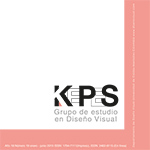Authors
Abstract
The generation of communication strategies that allow bringing the visually impaired public closer to museums has become an important challenge for museology. As a response to this need, a navigation system for inner environments was designed, prototyped and evaluated, which allows visually impaired people to access exhibitions at the La Salle Museum of Natural Sciences of the Instituto Tecnológico Metropolitano (Medellín, Colombia). The procedure used in this work is presented as a methodology with two stages. The first stage consisted of the design and development of the prototype of the navigation system, and the second stage was the evaluation of the system. The design of the system was the result of the adaptation of contemporary methodologies of innovation such as Design Thinking and Creative Problem Solving (CPS) applied to the design of technological products. A functional prototype which included an iOS app for smartphone, podotactile guides, bone conduction headphones, obstacle detectors and QR code identifiers, was developed. During the evaluation stage, experiments were conducted in one of the museum rooms with 27 people with visual disabilities. The results indicated that the developed system is effective as a navigational tool that provides information about the specimens of an exhibition, which allows concluding that this experience is replicable in other museographic environments and in other museums.
References
Ahmetovic, D. et al. (2017). Achieving practical and accurate indoor navigation for people with visual impairments. En 14th Web for All Conference on The Future of Accessible Work, ACM, Western Australia, Australia.
Basso, S. et al. (2015). A smartphone-based indoor localization system for visually impaired people. En International Symposium on Medical Measurements and Applications (MeMeA) Proceedings, Turin, Italy.
Bellotti, F. et al. (2006). Guiding visually impaired people in the exhibition. Mobile Guide, 6, 1-6.
Bhowmick, A. and Hazarika, S.M. (2017). An insight into assistive technology for the visually impaired and blind people: State-of-the-art and future trends. Journal on Multimodal User Interfaces, 11 (2), 149-172.
Buyurgan, S. (2009). The Expectations of the Visually Impaired University Students from Museums. Educational Sciences: Theory and Practice, 9 (3), 1191-1204.
Brown, T. (2009). Change by Design: How Design Thinking Transforms Organizations and Inspires Innovation. New York, USA: Harper Collins.
Campbell, M. et al. (2014). Where’s my bus stop?: Supporting independence of blind transit riders with StopInfo. En 16th International ACM SIGACCESS Conference on Computers & Accessibility, ACM, New York, USA.
Chumkamon, S., Tuvaphanthaphiphat, P. and Keeratiwintakorn, P. (2008). A blind navigation system using RFID for indoor environments. En 5th International Conference on Electrical Engineering/Electronics, Computer, Telecommunications and Information Technology, Krabi, Thailand.
Csapo, A. et al. (2015). A survey of assistive technologies and applications for blind users on mobile platforms: A review and foundation for research. Journal Multimodal User Interfaces, 9, 275-286.
Fallah, N. et al. (2012). The user as a sensor: Navigating users with visual impairments in indoor spaces using tactile landmarks. En CHI Conference on Human Factors in Computing Systems, ACM, Texas, USA.
Filipe, V. et al. (2012). Blind navigation support system based on Microsoft Kinect. Procedia Computer Science, 14, 94-101.
Flores, G. et al. (2015). Vibrotactile guidance for wayfinding of blind walkers. IEEE Transactions on Haptics, 8 (3), 306-317.
Ganz, A. et al. (2014). PERCEPT-II: Smartphone based Indoor Navigation System for the Blind. En 36th Annual International Conference of the IEEE Engineering in Medicine and Biology Society, Chicago, USA.
Handa, K., Dairoku, H. and Toriyama, Y. (2010). Investigation of priority needs in terms of museum service accessibility for visually impaired visitors. British Journal of Visual Impairment, 28 (3), 221-234.
Hurtado, M.D. y Soto, F.J. (2008). La igualdad de oportunidades en el mundo digital. Murcia, España: Consejería de Educación, Ciencia e Investigación.
Jain, D. (2014). Path-guided indoor navigation for the visually impaired using minimal building retrofitting. En SIGACCESS conference on Computers & Accessibility, ACM, New York, USA.
Jiménez, C., Seibel, C. y Soler, S. (2012). Museos para todos. La traducción e interpretación para entornos multimodales como herramienta de accesibilidad universal. MonTI. Monografías de Traducción e Interpretación, 4, 349-383.
Kleeman, L. (1992). Optimal estimation of position and heading for mobile robots using ultrasonic beacons and dead-reckoning. En Proceedings 1992 IEEE International Conference on Robotics and Automation, Nice, France.
Leavy, B. (2010). Design thinking–a new mental model of value innovation. Strategy & Leadership, 38 (3), 5-14.
Panëels, S.A. et al. (2013). The walking straight mobile application: Helping the visually impaired avoid veering. Recuperado de https:// smartech.gatech.edu/bitstream/handle/1853/51516/03_S1-2_Paneels.pdf?sequence=1&isAllowed=y.
Parnes, S.J. (1992). Sourcebook for creative problem solving. Buffalo, USA: Creative Education Foundation.
Perdomo, J. (2009). Una mirada a las prácticas de inclusión y de exclusión en los museos. Códice, 20, 16-21
Nakajima, M. and Haruyama, S. (2013). New indoor navigation system for visually impaired people using visible light communication. EURASIP Journal on Wireless Communications and Networking, 37. Recuperado de https://jwcneurasipjournals.springeropen.com/articles/10.1186/1687-1499-2013-37.
Nakamura, K., Aono, Y. and Tadokoro, Y. (1997). A walking navigation system for the blind. Systems and Computers in Japan, 28 (13), 36-45.
Soler, S. y Chica, A. (2014). Museos para todos, evaluación de una guía audiodescriptiva para personas con discapacidad visual en el museo de ciencias. Revista Española de Discapacidad, 2 (2), 145-167.
Shoval, S., Borenstein, J. and Koren, Y. (1998). Auditory guidance with the navbelt-a computerized travel aid for the blind. IEEE Transactions on Systems, Man, and Cybernetics, Part C (Applications and Reviews), 28 (3),459-467.
Ulrich, K. and Eppinger, S. (2015). Product design and development. New York, USA: McGraw-Hill Higher Education.
Xie, B. et al. (2016). LIPS: A light intensity based positioning system for indoor environments. ACM. Transactions on Sensor Networks, 12 (4), 28-42.
Wylant, B. (2008). Design thinking and the experience of innovation. Design Issues, 24 (2), 3-14.

 pdf (Español (España))
pdf (Español (España))
 FLIP
FLIP





















